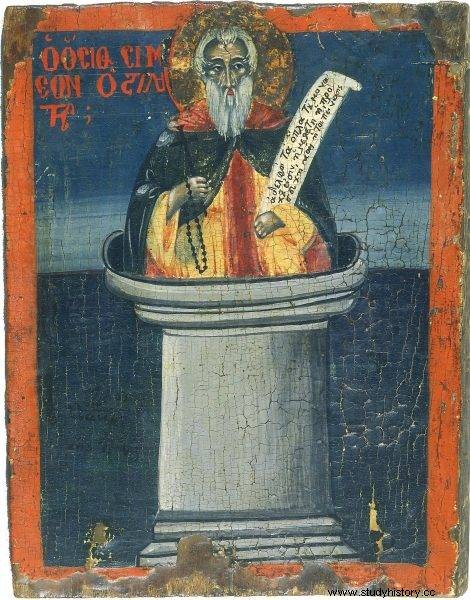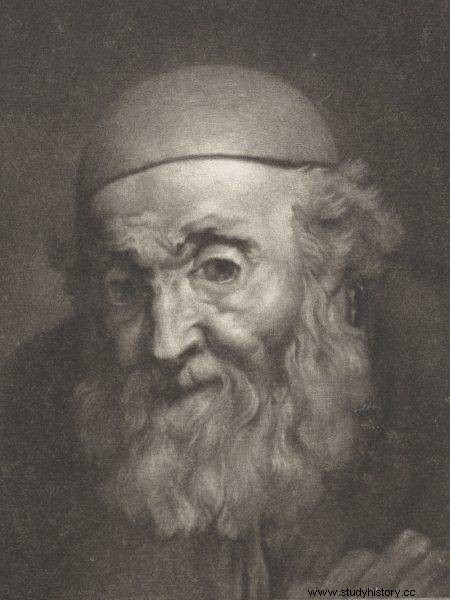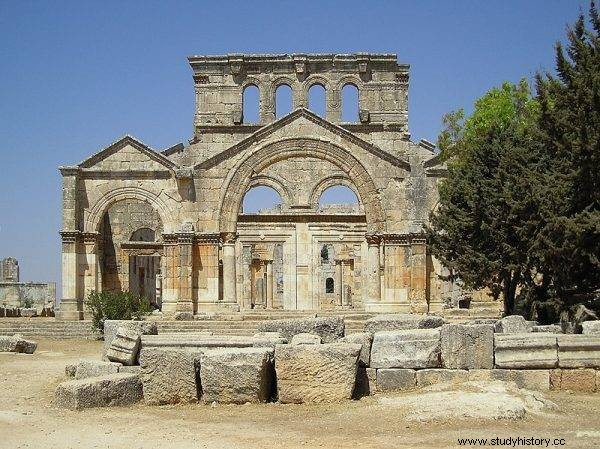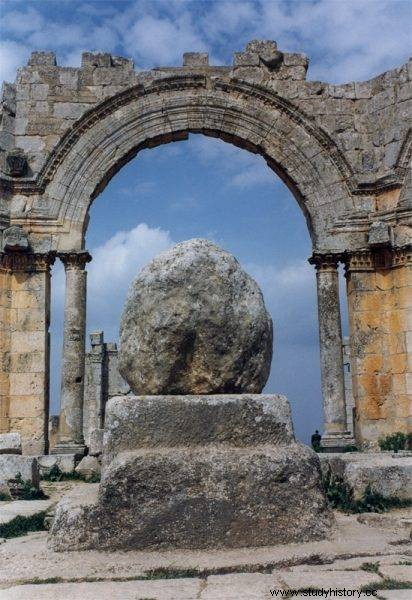For 37 years he did not leave the tiny platform 18 meters above the ground. Here he ate what he got from people, he slept here, prayed and gave sermons. His only protection against cold, rain, snow, scorching sun and wind was a cape with a hood. In the 5th century, Szymon Słupnik contemplated and glorified God in this way. Already during his lifetime, crowds of onlookers and pilgrims gathered under his pillar. Even the Byzantine emperors made pilgrimages there. His victim still arouses astonishment and provokes questions - also about the meaning of asceticism.
Simon, later called Słupnik, was born around 390 in today's Turkey, in Sis, on the border of Cilicia and Syria. He was born into a large family of shepherds. However, he was soon left alone in the world. His relatives were taken by sickness and death.
Death seeker
Soon after that, Simon decided that instead of running the farm, he would devote himself to the spiritual life. Reportedly, after reading the Sermon on the Mount, he experienced a religious revelation. He was 13 years old at the time. Soon after, he sold his property, gave the money to the poor and became a hermit, a celibate hermit, avoiding people and entertainment. He joined the assembly of hermits in Telada. He lived among a hundred monks like himself for about 10 years, but finally said goodbye to the congregation.
He was looking for even greater isolation and asceticism. He entered a monastery in Telanissos (today Deir Sam'an at the foot of Kala't Sama'an 35 km from Aleppo in Syria), however quickly became known as an eccentric, exposing his body to extreme exhaustion . According to hagiographic descriptions, Szymon was supposed to bind himself with a rope made of palm sap, which was densely interwoven with thorns. He also ordered to lock himself in a stone cistern for water.

Szymon quickly became known as an eccentric, exposing his body to extreme exhaustion.
The eccentric, suffering life of the hermit turned out to be unsuitable for the religious authorities. He was asked to leave the community. He did so. For a year and a half, he lived in a modest cottage. Apparently, when he survived 40 days of Lent without food or drink, it was considered a miracle. Later he moved to a mountain cave. According to the hagiographers: "he lived in a cave so narrow that he could not stretch his legs in it", and "chained himself to the boulder with a chain several meters long".
Unfortunately, he did not manage to escape the vanity of this world. His mortifications became so famous that while he condemned his body to suffering, keeping his mind disciplined and focused on the spiritual reality, even among the rocks stares flocked to him.
Pole
Therefore, he found another solution. He chose to live between earth and heaven. Originally a stone pillar he built himself (according to another version he found the base of the pillar among the ruins, which he later extended), it was 10 feet, or about 3 meters. With time, however - perhaps under the influence of impassioned onlookers and admirers who sought the sage's advice - Simon raised his pole until finally the structure on which he spent all his days reached a height of 18 meters.
He was the first Christian hermit to undergo such asceticism, but it should be noted that this form of mortification also had his pagan counterpart . A certain Lukyan, a Roman writer and chronicler in his work "De Dea Syria" recalled in the 2nd century about pagan ascetics from Hierapolis in Phrygia (present-day Manbij in Syria) who moved to the poles twice a year for several weeks to meditate there for two weeks. The so-called stationaries - Christian ascetics who put to death their bodies, purified their souls and drew closer to God ... standing in one place for days outside, without shelter, in rain, heat, sandstorm, storm - regardless of the weather.

A certain Lukyan, a Roman writer and chronicler in the work "De Dea Syria" mentioned in the 2nd century about pagan ascetics from Hierapolis in Phrygia
How is it possible to live above ground? Szymon had at his disposal a wooden platform surrounded by a balustrade with a side more than a meter long (perhaps up to two meters). So there was no question of walking. He slept on the platform, stood and sat. And so for years. His only garment was a hooded cloak. He drank rainwater. He ate as little as possible - what he got from local residents. He hauled the gifts upstairs in a bucket attached to a rope.
It survived under such conditions for nearly 40 years. Twice a day he preached to people from the summit. Those who wanted more private advice or just be closer to the master could do so by climbing a ladder attached to a pole. This allowed them to come close enough to him to talk.
Vanity or humility?
Apparently, when he began his life on a pole, the older religious brothers decided to find out what the real purpose of the hermit was. Are they really being prompted by angelic or hellish powers? They went to the pole and ordered Simon to descend and submit to normal life. It was supposed to be a test of humility. Simon went down. After he did so, the brothers withdrew and allowed him to return to function on earth.
The unique way of existence attracted thousands of people to the hermit's pillar, including pagans - Jews, Arabs and Persians. Asceticism, or mortification of the body, was a form of cleansing from hellish, carnal temptations and thus getting closer to God . That is why the ascetics were seen as heroes, holy men, sages.

Ruins of St. Simeon Słupnik (Arabic:Qala'at Samaan) located near Aleppo in Syria
Apparently, the sacrifice of Szymon Słupnik converted thousands of people. Some came to see, some for advice, some for healing. According to one legend, one time a leper daughter of one of the local nobles climbed a pole. This happened after the pistol asked her in advance for water. The girl handed it to him while covering her face. When asked why she was doing this, she replied that it was unclean. Then Simon drank from her and poured the rest on her face, from which the traces of the disease were to disappear immediately.
A more human Jesus ...
The fame of the sage from Antioch radiated throughout the empire. It is said that one day none other appeared under the pillar, but the Byzantine emperor Marcian. The hermit who lived in a patch of space was to send letters with his message to Emperor Theodosius II and St. The Parisian genoweph.
Apparently the letters show moderation and common sense, as well as clarity of argumentation, which may be surprising in the context of the uncompromising nature of the hermit and the extreme conditions in which he lived. He seemed to be in the depths of madness, meanwhile he had a more sober view of reality than many at the bottom.
A hermit from his scrap of a world where he could only sit or stand, he defended Christianity against heresy. In the fifth century, Christ's faith struggled with a doctrinal crisis. The so-called The Nestorians proclaimed that Christ was not God but only man where God resided (logos). He came into the world as a human and only later obtained divine grace. On the basis of this doctrine (created by the Patriarch of Constantinople - Nestorius), Mary could not be said to be the Mother of God. The ascetic objected to this. Through the sermons of Simon, Emperor Leo I supported the Council of Chalcedon. During the deliberations, the clergy recognized Christ as a God-Man who, as a result of the incarnation, became a person of both divine and human nature.
The Lord called them to the pillar
Saint Szymon Słupnik died on August 28, 459, at the age of 69. He passed away as a famous man. As strange as it sounds, he achieved the status of a celebrity at the time, as evidenced by his funeral, which brought dignitaries (including the Patriarch of Antioch), bishops, the imperial governor, monks and faithful to the vicinity of Aleppo. His body was solemnly transported to Antioch in Syria, and then to Constantinople. The skull of Simeon Slupnik is believed to be in the Camaldolese monastery in Arezzo.

Remains of Simon's column
For several years, the faithful gathered on the spot where its pillar stood. Later, a temple was built there, which was called Qala'at Samaan (Arabic:Simon's Fortress). Unfortunately, during the war in Syria, the well-preserved ruins of the temple, as well as the remains of the pillar / stone column on which the saint lived his life, were bombed and almost completely destroyed by the forces of the Islamic State.
Soon after the death of the hermit in Asia Minor, there was a real "flood" of postmen. The so-called stylists (from Greek - servants) indulged in this form of asceticism, often in the centers of cities and settlements . They aroused admiration, and the poles on which they contemplated themselves were places of pilgrimage for the faithful. The history of the lives of saints is especially distinguished by Simon the Servant II, who also came from Antioch. He was born in 520. In life on high, he pierced his master. He has survived on the pole for over 45 years without interruption. Hagiographers claimed that St. Szymon Słupnik the Younger (like the elder, became a saint of the Catholic and Orthodox Church) talked with angels and demons over the earth.
It seems that today, in mass reception, the stories of not only stylites but also of other ascetics may arouse more astonishment than admiration. In a secularized commercial world their victim may be met with misunderstanding and instead of being viewed in spiritual terms, it could be treated as a kind of show.
Even before the era of social media and mass communication, the figure of Szymon Słupnik inspired and aroused controversy. In our poetry, their beautiful, though dark, trace has been preserved in the form of a poem by Stanisław Grochowiak, written in 1956, Święty Szymon Słupnik The poet iconoclastic compares the voluntary sacrifice of a saint "called by the Lord to a pillar", who spent years in isolation on the mountain, to the suffering of ordinary people - victims of crimes and rape:lynchiness on a young man ("The Lord called him, for the stryk"), gang rape of a woman ("The Lord called her to be dung").
What is worse for their sacrifice than the life of the holy Servant? - the artist who created his poem after the hecatomb of the Second World War and the dark period of Stalinism seems to ask. Why is one person waiting for glory, his suffering brings salvation, and the other's suffering only meaningless death? It is also a question about the real value of - in a certain sense convenient - isolation, also from the cruelty and violence of this world. So is asceticism, the life of a hermit a real heroism, a show of spiritual strength? Or maybe an escape from reality and the need to confront it? The figure of Szymon Słupnik will provoke similar questions more than once.
